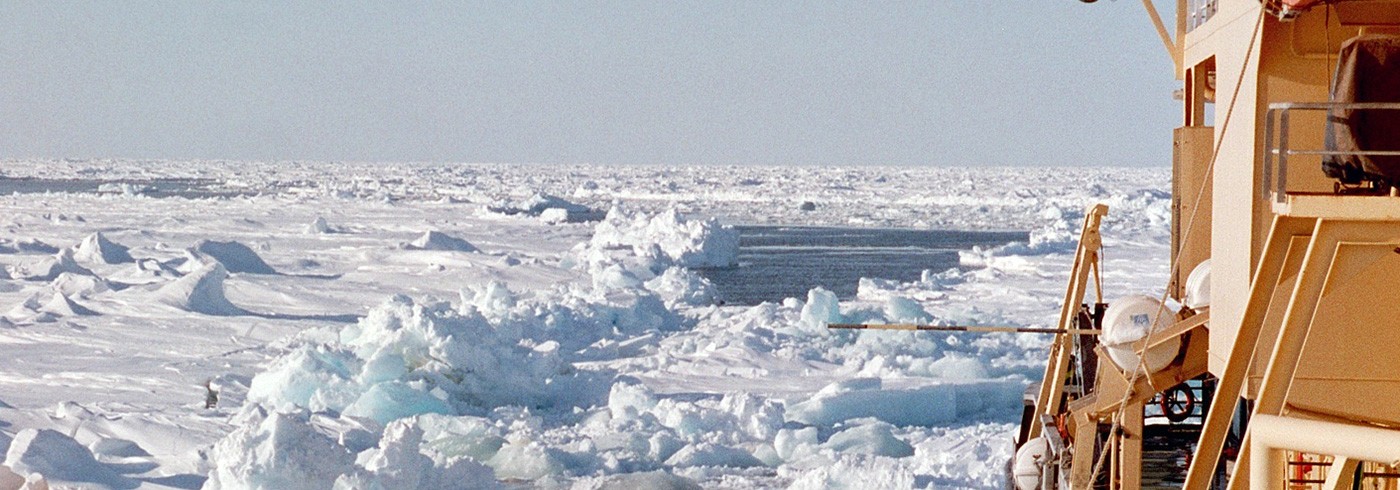Organic contaminants in the East Greenland Sea – origin, fate and circulation
Aim
It may be difficult to believe that compounds you can hold as a powder in the palm of your hand can be transported via the air to remote areas. Nevertheless today we find organic contaminants, such as the well known pollutant DDT, in all regions of the world, even the regions most remote from the emission sources.
A small proportion of almost all organic compounds occur in the air as a gas. The proportion of any compound in the gas phase will be higher in warm climates than in cold ones. The global distribution is, therefore, thought to occur by a temperature-driven process in which compounds in the gas phase are “drawn” to the cold polar areas (Wania and Mackay, 1996). This is called “The Cold Wall Effect” and is similar to what happens when frost accumulates on the cold surface of an ice cream container that is taken out of the freezer on a warm summers day. The water vapour in the air condenses on the cold surface and creates a local depletion of water vapour close to the ice cream container so that more water vapour is “drawn” from the surrounding air towards the container.
The current interest in organic contaminants in the Arctic started in the late 1980’s when it was found that people living in the Arctic have much higher levels of persistent organic pollutants in their bodies than those living in industrialised areas do. Recent findings also indicate that some populations of polar bears have such high body burdens of PCB that it affects their reproduction negatively. However, as the Arctic is difficult to access our understanding of the transport of pollutants to and from the Arctic is still fragmentary. We also need to know more about the degradation processes and rates of degradation of organic pollutants in the Arctic, to understand the ultimate fate of the contaminants and the time scale of the problem.
It is of increasing importance to study “new” contaminants. These are not necessarily new in the sense that their production started recently; many of them are anthropogenic compounds that have been around for a long time, but that no one has measured in the field previously. These include some persistent organic pollutants with structures related to PCB and DDT, such as polychlorinated naphthalenes and brominated flame-retardants. Currently used pesticides are also among the “new” compounds.
My work on the Arctic Ocean 2002 expedition was aimed mainly at sampling for determination of hexachlorocyclohexanes, a class of persistent compounds that includes the insecticide lindane. Samples that will allow the determination of other persistent organic pollutants and currently used pesticides were also collected. The samples will also be investigated for compounds thought to be of anthropogenic origin, but that may actually be natural products. As there are virtually no data from the area any data from this expedition will help fill in important knowledge gaps.
Work on board
The work on board consisted mostly of air and water sampling. It is important to sample both water and air to understand the circulation of the pollutants in the area visited all along the expedition route. At some sampling stations depth gradients were taken through the water column. Some samples of ice/snow and brine were collected.
The air and surface water data will be used to calculate the current balance of air transport and deposition/revolatilisation of some contaminants to the East Greenland Sea. The deep-water profiles are of particular interest to estimate the microbial degradation rate of some compounds. During the expedition Arctic Ocean 1996 we developed a method to use the degradation of chiral compounds to estimate their degradation rate. A chiral compound has a “left-handed” and a “right-handed” form that are physically and chemically similar, but that may have different biological effects and degradation rates. By measuring the two forms separately we can construct a clock to estimate the microbial degradation rate (Harner et al., 1999). The particular hope for Arctic Ocean 2002 is to use the “ventilation age” other participants in the expedition can calculate from their CFC data to get a more reliable estimate of the degradation rates than has been possible on other expeditions.
Preliminary results
Because of the complexity of the analytical procedure no analyses of samples were possible on board and no results are available as yet.
Dates
April–June 2002
Participants
Principal investigator
Henrik Kylin
Department of Environmental Assessment, Swedish University of Agricultural Sciences
Uppsala, Sweden
References
Harner, T., Kylin, H., Bidleman, T. F., and Strachan, W.M.J., 1999. Removal of α- and γ-Hexachlorocyclohexane and Enantiomers of α-Hexachloro-cyclohexane in the Eastern Arctic Ocean. Environmental Science and Technology 33(8), 1157–1164.
Wania, F. and Mackay, D.E. 1996. Tracking the distribution of persistent organic pollutants. Environmental Science and Technology 30, 390A–396A.

